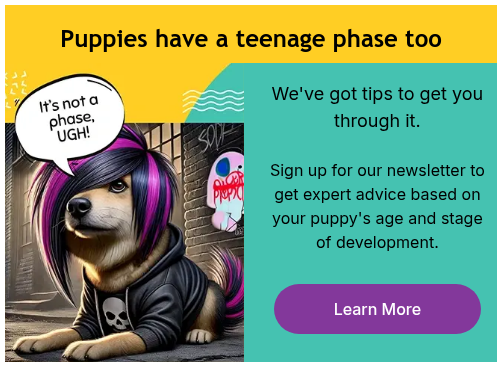 Engage–Disengage is one of my favorite dog training games, and I use it with clients dealing with a variety of dog behavior issues, as well as with my own dogs.
Engage–Disengage is one of my favorite dog training games, and I use it with clients dealing with a variety of dog behavior issues, as well as with my own dogs.
This game teaches your dog how to notice someone (or something) in their environment and then disengage on their own, without any verbal cue from you. It's an exercise of self-interruption and impulse control.
The most common use of engage-disengage is with dogs who exhibit leash reactivity.
Playing this game is beneficial because it's working through both classical conditioning and operant conditioning.
Classical counter conditioning is: changing your dog's emotional response to the appearance and presence of someone or something in their environment.
Operant conditioning is: teaching your dog what to do when they notice that person or thing. By playing engage-disengage with your dog you're helping them feel something positive and do something desirable.
Overall, engage–disengage is a great starting point for dog owners who are implementing a desensitization and counter-conditioning behavior plan for dogs with leash reactivity or aggression.
If you're struggling with leash reactivity or aggressive behavior with your dog, working with a certified professional dog trainer or behavior consultant is essential to getting a personalized training plan and support.
The engage-disengage game is only one piece of the training puzzle! Connect with me for dog training and behavior help in a virtual one-on-one dog behavior consultation.
Engage–Disengage is Perfect for:
- Dogs who struggle with leash reactivity or aggressive behavior
- Fearful or anxious dogs
- Puppy socialization
- Dogs with high prey drive, who like to chase squirrels, birds, or other animals
- Dogs who are easily excitable or have trouble focusing
How to Play Engage–Disengage with Your Dog
What You'll Need:
- Your clicker or marker word
- High-value training treats (think soft and smelly, like turkey hotdog, string cheese, or chicken breast)
- A treat pouch for your treats (my favorite for carrying fresh treats is the high-grade silicone Voilà Ultimate Treat Pouch)
- An understanding of your dog's threshold
Before You Play: Managing Your Dog's Threshold
The most important part of this game is that you're only playing it when your dog is under threshold.
What does this mean? Under threshold means your dog is far enough away from the person, another dog, or thing in the environment that they can notice it but not "lose their brain."
The goal is to work at a distance or intensity where your dog is still able to think and make good choices! Over time, this distance is decreased as your dog learns how to cope.
For an in-depth explanation of a threshold in dog training, check out this portion of my Yappy Hour about Leash Reactivity:
- Find and maintain a distance where your dog notices but isn't overreacting. If your dog is growling, barking, lunging, OR trying to hide and run away, you're too close!
- Be aware of other forms of intensity. Some dogs go over threshold based on the duration that the person, dog, or thing, is present. They may be okay for the first 30 seconds, but after that, it's too much! Know your dog's limits.
Step One: Engage!
This first step is all about teaching your dog that looking at — and not reacting to — their trigger is a fantastic thing!
- When your dog looks at their trigger (person, dog, another thing) — click or say "yes!" as they look. Immediately give your dog a treat, encouraging them to turn their head towards you to take it.
- If your dog is familiar with a clicker or marker word, you should see them orient towards you in anticipation when they hear it. That's what we want!
- If they look back at their trigger, click/mark again and treat. Repeat!
If your dog ignores the marker and the treat, you're most likely too close to the trigger. Add distance to where your dog is showing more interest in taking a treat, while still noticing their trigger.
Practice this step for a few days before moving to step two.
Step Two: Disengage!
The second part of this game is reinforcing your dog's choice to disengage from staring at their trigger ON THEIR OWN. Your dog self-interrupts any unwanted staring and fixation, which usually leads to overreacting, and instead looks to you.
- When your dog looks at their trigger, start to count to three (in your head).
- If they look back at you before you reach the count of three, click or say "yes!" when they look at you. Treat and repeat!
- If they don't look back at you before the count of three, that's okay. Simply do step one, marking and treating for looking at their trigger.
If your dog isn't looking back at you by the count of three, that could mean they aren't ready for step two quite yet. Continue practicing step one.
But it may also mean that they are getting closer to going over threshold, so stay aware of how far away you are from their trigger or the intensity levels.
This video from Train Me Please provides a wonderful overview of the above steps, from how to manage threshold to working both steps one and two:
Engage–Disengage Dog Training Videos
Timing is important, as well as managing your dog's distance from their trigger. Below are a few videos showing dogs playing engage–disengage so you can see how it works.
This first video is my dog Fozzie Bear. He is leash reactive, mostly based in excitement and frustration rather than fear.
You'll notice in this video that when the dog passing us is very close, I switch from playing engage–disengage to distracting him with a Find It cue, and then back to engage–disengage. He has a few months of experience playing this game.
This video is one of my favorite examples of playing engage–disengage with a dog while settled, compared to when on a walk.
This is a great way to introduce the game to work on teaching your dog not to chase squirrels or birds. Sit in a park with your dog on a leash, and when they notice the animal at a distance, start the game!
This video is another I often share with training clients, so they can see how to play this game while out and about in different environments.
Have questions about playing this game with your dog? Let me know in the comments!




